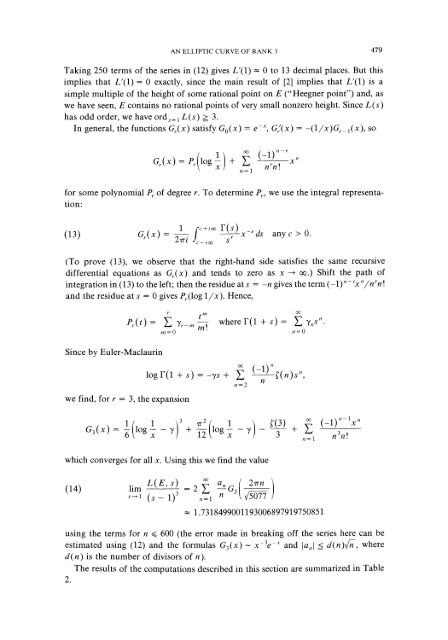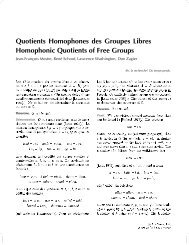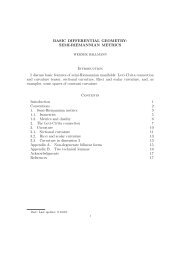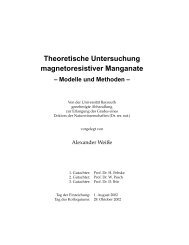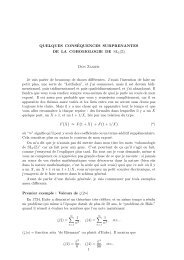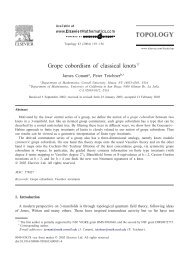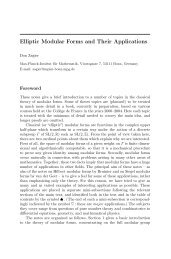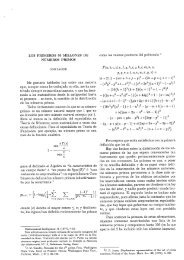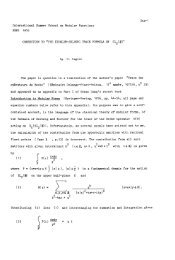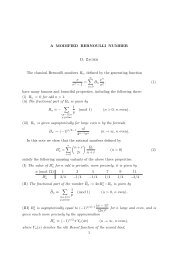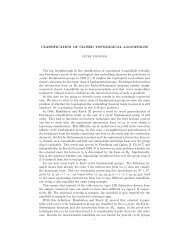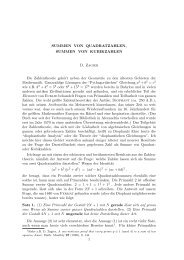On the Conjecture of Birch and Swinnerton-Dyer for an ... - Up To
On the Conjecture of Birch and Swinnerton-Dyer for an ... - Up To
On the Conjecture of Birch and Swinnerton-Dyer for an ... - Up To
Create successful ePaper yourself
Turn your PDF publications into a flip-book with our unique Google optimized e-Paper software.
AN ELLIPTIC CURVE OF RANK 3 479Taking 250 terms <strong>of</strong> <strong>the</strong> series in (12) gives L'(1) = 0 to 13 decimal places. But thisimplies that L'(1)= 0 exactly, since <strong>the</strong> main result <strong>of</strong> [2] implies that L'(1) is asimple multiple <strong>of</strong> <strong>the</strong> height <strong>of</strong> some rational point on E ("Heegner point") <strong><strong>an</strong>d</strong>, aswe have seen, E contains no rational points <strong>of</strong> very small nonzero height. Since L(s)has odd order, we have ords= 1 L(s) ? 3.In general, <strong>the</strong> functions Gr(x) satisfy Go(x) = e-x, Gr'(x) = -(1/x)Gr_1(x), soGr(X) = Pr (log 1-) + E r lrn!<strong>for</strong> some polynomial Pr <strong>of</strong> degree r. <strong>To</strong> determine Pr, we use <strong>the</strong> integral representation:(13) Gr(X) = 2 fi | () x- ds <strong>an</strong>yc > 0.(<strong>To</strong> prove (13), we observe that <strong>the</strong> right-h<strong><strong>an</strong>d</strong> side satisfies <strong>the</strong> same recursivedifferential equations as Gr(x) <strong><strong>an</strong>d</strong> tends to zero as x -> ox.) Shift <strong>the</strong> path <strong>of</strong>integration in (13) to <strong>the</strong> left; <strong>the</strong>n <strong>the</strong> residue at s = -n gives <strong>the</strong> term (-1)" rx "/nr n!<strong><strong>an</strong>d</strong> <strong>the</strong> residue at s = 0 gives Pr(log 1/x). Hence,Since by Euler-Maclaurinr t "71 ??Pr(t) = Yr-rn m where 17(1 + s) - y,1s"7=0 17 = 0we find, <strong>for</strong> r = 3, <strong>the</strong> exp<strong>an</strong>sion00(_)log 17(1 + S) = --ys + E ~ (n=2)SnG3 (X)= +~3 -(log? -v)- + (1h1xPG()=6 (lg-Y 12 (lgx 7 17l3 n3n!which converges <strong>for</strong> all x. Using this we find <strong>the</strong> valueii=1n(14) lim L( 3s-2 -AG(3~s-(I (s - 1) =n 50771.7318499001193006897919750851using <strong>the</strong> terms <strong>for</strong> n < 600 (<strong>the</strong> error made in breaking <strong>of</strong>f <strong>the</strong> series here c<strong>an</strong> beestimated using (12) <strong><strong>an</strong>d</strong> <strong>the</strong> <strong>for</strong>mulas G3(x) X-3e-x <strong><strong>an</strong>d</strong> _jaj11 d(n)rn, whered(n) is <strong>the</strong> number <strong>of</strong> divisors <strong>of</strong> n).The results <strong>of</strong> <strong>the</strong> computations described in this section are summarized in Table2.


